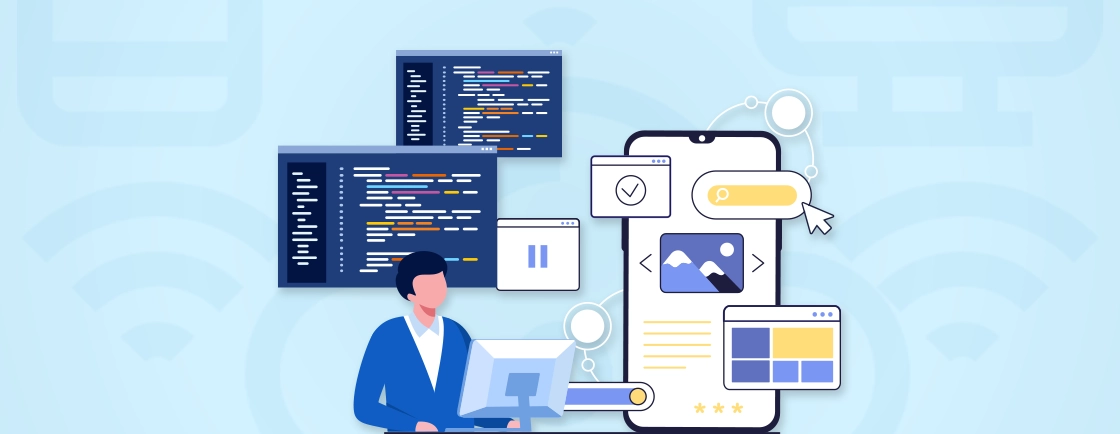Table of Contents
Nowadays, in almost every single mobile app–whether it’s for gaming, shopping, banking, social media chatting, etc.–users have to dole out their personal info. Like, mail id, contact number, bank account/card info, payment wallet id, and more.
So the users are vulnerable to cyberattacks, which have surged quite significantly. It has exposed sensitive user data and cost millions to businesses and individuals around the world. That makes security one of the most significant points of discussion, whether you are building a mobile app or customizing an existing one.
So through this blog, we’ll look at the key components and strategies of mobile app security, from encryption to secure authentication. Plus, you’ll be able to understand the security risks and how to mitigate them. Let’s begin.
Importance of Mobile App Security
Mobile app security is the practice of securing a mobile application from cyber threats, unauthorized access, and data breaches. It encompasses secure coding practices, encryption, authentication protocols, and regular vulnerability testing. So you can ensure user data remains private and apps function as intended—without exploitation.
Smartphone apps handle everything from banking to healthcare. So weak app security can lead to stolen credentials, financial fraud, or even identity theft. Mobile app security involves safeguarding against risks like malware, insecure APIs, and phishing attacks.
Ultimately, mobile app security isn’t just about preventing hacks. It’s about building trust in an increasingly app-driven world.
Key Components of Mobile App Security
A robust mobile app security strategy relies on multiple layers of protection. Here are the essential components every developer and organization should implement:
Secure Authentication & Authorization
Weak login systems are a hacker’s easiest entry point. Implement multi-factor authentication (MFA), OAuth 2.0, and biometric verification to ensure only legitimate users gain access.
Data Encryption
Sensitive data—whether stored on a device or transmitted over networks—must be encrypted. Use AES-256 for storage and TLS 1.2+ for data in transit to prevent interception.
Secure APIs
APIs power app functionality but can expose vulnerabilities if improperly secured. Enforce strict authentication, rate limiting, and input validation to block malicious requests.
Regular Security Updates
Outdated code and libraries are prime targets. Patch vulnerabilities promptly and monitor third-party dependencies for known risks.
Runtime Protection
Even well-built apps can be attacked while running. Use runtime application self-protection (RASP) and anti-tampering measures to detect and block exploits in real time.
Secure Backend Infrastructure
A vulnerable server can compromise an entire app. Harden cloud storage, databases, and APIs with firewalls, intrusion detection, and least-privilege access controls.
User Privacy Compliance
Regulations like GDPR and CCPA require apps to handle data responsibly. Ensure transparent data collection, user consent, and minimal data retention policies.
It’s important to integrate these components into development and maintenance. That’s what helps protect users, maintain trust, and avoid costly breaches. For that, you can hire dedicated mobile app developers.
Best Mobile App Security Practices
Mobile apps handle sensitive data daily, like financial transactions, personal communications, health records, and more. But still, many lack robust security. A single breach can lead to massive financial losses, legal consequences, and eroded user trust.
Here are a few proven strategies to secure a mobile app.
Go for the “Secure By Design” Approach
Security shouldn’t be bolted on—it should be built in. A “Secure by Design” philosophy means integrating security from the first line of code, not as an afterthought. This includes threat modeling during development, adopting secure coding practices, and minimizing attack surfaces.
Apps designed with security in mind are inherently more resilient, reducing costly fixes and breaches down the line.
What to Do
- Conduct threat modeling early to identify risks.
- Follow OWASP Mobile Top 10 guidelines during development.
- Use secure coding practices to prevent common vulnerabilities.
- Integrate security into CI/CD pipelines with automated checks.
- Train developers on secure coding and emerging threats.
- Document security protocols for future audits and updates.
Implement Strong Authentication
Weak passwords and single-factor logins are low-hanging fruit for hackers. Strengthen access control with multi-factor authentication (MFA), biometrics (Face ID, fingerprint), and adaptive authentication that assesses risk in real time.
A single stolen password shouldn’t be enough to compromise an entire account.
What to Do
- Enforce Multi-Factor Authentication (MFA) for critical actions.
- Use OAuth 2.0 or OpenID Connect for secure third-party logins.
- Implement biometric authentication (Face ID, Touch ID).
- Set strong password policies (minimum length, complexity).
- Limit login attempts to prevent brute-force attacks.
- Monitor for suspicious login activity (unusual locations, devices).
Encrypt Data at Every Stage
Unencrypted data is a goldmine for attackers. AES-256 encryption for stored data and TLS 1.3 for data in transit ensure that even if hackers intercept communications or breach storage, the information remains unreadable.
Never rely on default encryption—customize it to your app’s specific risks.
What to Do
- Use AES-256 encryption for stored data.
- Enforce TLS 1.2+ for all network communications.
- Implement certificate pinning to prevent MITM attacks.
- Encrypt sensitive files & databases (SQLite, Realm).
- Avoid hardcoding keys—use secure key management.
- Wipe cached data when sessions end.
Secure Your APIs & Backend
APIs are the backbone of mobile apps—but they’re also prime targets. Enforce strict authentication (OAuth 2.0, API keys), input validation, and rate limiting to block malicious requests. A single unsecured API endpoint can expose your entire system.
What to Do
- Authenticate & authorize every API request.
- Use rate limiting to block DDoS & brute-force attacks.
- Validate & sanitize all API inputs to prevent injections.
- Hide sensitive API endpoints from public exposure.
- Log & monitor API traffic for anomalies.
- Conduct regular API penetration testing.
Protect Against Reverse Engineering & Tampering
Hackers can decompile apps to steal code, inject malware, or bypass security. Obfuscate code, use anti-tampering checks, and implement Runtime Application Self-Protection (RASP) to detect and block real-time attacks.
What to Do
- Use code obfuscation (ProGuard, R8 for Android).
- Implement anti-debugging & anti-tampering checks.
- Sign your app to detect unauthorized modifications.
- Use RASP (Runtime Application Self-Protection).
- Detect & block rooted/jailbroken devices.
- Employ app shielding solutions (like DexGuard).
If your app handles sensitive data, these defenses are non-negotiable.
Regularly Update & Patch Vulnerabilities
Cyber threats evolve daily—so should your app. Outdated libraries, SDKs, and dependencies are common entry points for exploits. Establish a patch management process to fix vulnerabilities quickly before attackers exploit them.
What to Do
- Monitor for new vulnerabilities (CVE databases).
- Patch third-party libraries (e.g., Log4j, OpenSSL).
- Schedule mandatory app updates for critical fixes.
- Maintain backward compatibility without sacrificing security.
- Notify users about security updates transparently.
- Test patches thoroughly before deployment.
Follow Privacy Regulations
Cyber threats evolve daily—so should your app. Outdated libraries, SDKs, and dependencies are common entry points for exploits. Establish a patch management process to fix vulnerabilities quickly before attackers exploit them.
What to Do
- Conduct Data Protection Impact Assessments (DPIAs).
- Minimize data collection (only what’s necessary).
- Provide clear privacy policies & user consent options.
- Allow users to delete their data (GDPR “Right to Erasure”).
- Anonymize or pseudonymize sensitive data.
- Audit compliance with GDPR, CCPA, HIPAA (if applicable).
Test, Audit & Monitor Continuously
Security isn’t a one-time checklist. Penetration testing, static/dynamic analysis, and real-time monitoring help catch vulnerabilities before hackers do. Automated tools can scan for flaws, but manual ethical hacking uncovers what machines miss.
What to Do
- Run automated security scans (SAST, DAST, IAST).
- Conduct penetration testing at least twice a year.
- Monitor real-time threats (SIEM, SOC tools).
- Perform red team exercises to simulate attacks.
- Audit third-party SDKs & libraries for risks.
- Establish an incident response plan for breaches.
A single weak link can break your app’s security chain. By adopting these strategies, you’re not just protecting data—you’re safeguarding user trust and your brand’s reputation.
What is Mobile App Security Testing?
In mobile app security testing, you evaluate an application’s user data, privacy, or functionality to see if there are any vulnerabilities, weaknesses, and potential threats. It involves a combination of automated scans, manual penetration testing, and code reviews to identify security flaws before attackers exploit them.
Why It’s Critical
- Prevents data breaches, financial fraud, and reputational damage.
- Ensures compliance with GDPR, HIPAA, PCI-DSS, and other regulations.
- Protects against malware, reverse engineering, and API abuse.
Mobile app security testing is not optional—it’s a necessity for any app handling sensitive data. Proactive testing reduces breaches, builds user trust, and saves costs in the long run.
Mobile App Security Testing Methods
Ensuring robust security for mobile apps requires a multi-layered testing approach. So let’s look at the most effective testing methodologies used by the security professionals.
Static Application Security Testing (SAST)
SAST scans your app’s source code for vulnerabilities before compilation. It detects hard-coded credentials, insecure APIs, and coding flaws early in development. This method is ideal for DevSecOps, SAST tools like SonarQube or Checkmarx provide instant feedback.
While it can’t catch runtime issues, it’s essential for preventing basic security mistakes in your codebase.
What to Do
- Scan source code for hard-coded secrets (API keys, passwords).
- Detect insecure coding patterns (SQLi, buffer overflows).
- Check dependencies for known vulnerabilities (CVE databases).
- Review cryptographic implementations (weak algorithms, improper key management).
- Assess compliance with secure coding standards (OWASP, CERT).
- Integrate with CI/CD pipelines for automated early detection.
Dynamic Application Security Testing (DAST)
DAST tests running apps by simulating attacks like SQL injection or XSS. Unlike SAST, it examines behavior in real-time but doesn’t need source code access.
Tools like OWASP ZAP or Burp Suite help find vulnerabilities in live environments. That makes DAST crucial for identifying runtime security gaps.
What to Do
- Simulate attacks (SQLi, XSS, CSRF) on live apps.
- Test authentication & session management flaws.
- Check server misconfigurations (exposed admin panels).
- Scan for data leakage (cached files, logs).
- Assess network security (TLS weaknesses, MITM risks).
- Validate input/output handling (fuzzing, malformed requests).
Interactive Application Security Testing (IAST)
IAST combines SAST and DAST by analyzing code during execution. It detects vulnerabilities in real-time with minimal false positives. Tools like Contrast Security integrate into CI/CD pipelines, offering deeper insights than standalone SAST or DAST.
It’s best for complex apps needing thorough, automated security validation.
What to DO
- Monitor app behavior during execution.
- Detect vulnerabilities in business logic.
- Trace data flow to find hidden exposure points.
- Identify runtime dependencies risks.
- Provide precise vulnerability locations (file, line number).
- Reduce false positives via contextual analysis.
Penetration Testing
Penetration testers simulate real-world attacks to exploit weaknesses. Unlike automated scans, manual penetration testing uncovers logic flaws, business risks, and advanced threats. Ethical hackers use tools like Metasploit to breach apps, providing actionable fixes.
This method is Critical for high-risk apps (banking, healthcare) before launch.
What to Do
- Conduct reconnaissance (app mapping, entry points).
- Exploit authentication flaws (brute force, session hijacking).
- Test privilege escalation (user → admin rights).
- Attempt data extraction (DB leaks, insecure storage).
- Bypass security controls (root/jailbreak detection).
- Deliver actionable reports with risk ratings & fixes.
API Security Testing
APIs are prime attack targets—this testing checks authentication, data leaks, and DDoS vulnerabilities. Tools like Postman or Akamai validate endpoints for insecure requests, excessive data exposure, or broken access controls.
It ensures your backend won’t become an entry point for hackers.
What to Do
- Test authentication/authorization (JWT, OAuth flaws).
- Fuzz API endpoints (malformed inputs, injections).
- Check rate limiting & DDoS protections.
- Verify data validation (input sanitization).
- Assess insecure direct object references (IDOR).
- Review API documentation for information leaks.
Reverse Engineering & Tamper Testing
Hackers decompile apps to steal code or inject malware. This test assesses how easily your app can be reverse-engineered using tools like Jadx or Frida. Solutions like obfuscation (ProGuard) and anti-tampering checks help block unauthorized modifications.
What to Do
- Decompile app binaries (APK/IPA) to assess exposure.
- Test anti-tampering defenses (checksum verification).
- Bypass root/jailbreak detection.
- Modify app behavior (patch security checks).
- Extract sensitive data (API keys, encryption secrets).
- Evaluate obfuscation effectiveness (ProGuard, R8).
Runtime Application Self-Protection (RASP)
RASP embeds security directly into the app to block attacks during execution. It detects malware, tampering, or suspicious behavior in real-time. Tools like Guardsquare or Immunio prevent zero-day exploits without requiring constant updates.
What to Do
- Detect abnormal behavior (code injection, hooking).
- Block tampering attempts (debuggers, emulators).
- Prevent memory-based attacks (buffer overflows).
- Alert on suspicious API calls.
- Enforce secure data handling.
- Integrate with threat intelligence feeds.
Compliance & Privacy Testing
Ensures your app meets GDPR, HIPAA, or CCPA standards. Audits data collection, storage, and user consent flows. Tools like OneTrust automate checks for privacy risks, avoiding legal penalties and building user trust.
What to Do
- Audit data collection/storage practices.
- Verify user consent mechanisms.
- Check data minimization compliance.
- Test “Right to Erasure” functionality.
- Assess third-party SDK risks.
- Validate encryption standards (AES-256, TLS 1.2+).
A well-structured security testing approach for the mobile app can minimize the blind spots and ensure protection against evolving threats.
Most Common Security Risks in Mobile Applications
Mobile apps face constant threats from hackers looking to exploit weaknesses. Let’s check out the most critical vulnerabilities that put user data and business reputations at risk.
Insecure Data Storage
Many apps store sensitive data (passwords, tokens, PII) in plaintext or weakly encrypted formats. Attackers exploit this via rooted devices or malware. Always use strong encryption (AES-256) for local storage, secure key management, and avoid caching sensitive data unnecessarily.
Fix: Use AES-256 encryption, secure keychains, and disable unnecessary logging.
Code Tampering & Reverse Engineering
Hackers decompile apps to modify code, inject malware, or steal IP. Prevent this with obfuscation (ProGuard), anti-tampering checks, and app shielding solutions. Regular integrity checks can detect unauthorized modifications.
Fix: Apply obfuscation (ProGuard, DexGuard), anti-tamper checks, and runtime protection.
Insecure APIs & Backend Systems
Poorly secured APIs expose apps to data breaches. Common issues include weak authentication, excessive data exposure, and lack of rate limiting. Always validate inputs, enforce strict access controls, and encrypt API communications.
Fix: Enforce OAuth 2.0, rate limiting, input validation, and regular pentesting.
Man-in-the-Middle (MitM) Attacks
Attackers intercept unencrypted network traffic to steal data. Prevent MitM attacks with TLS 1.2+, certificate pinning, and avoiding public Wi-Fi for sensitive transactions.
Fix: Implement TLS 1.3, certificate pinning, and avoid plain HTTP.
Authentication & Authorization Flaws
Weak login systems (no MFA, poor session management) let attackers hijack accounts. Enforce strong passwords, multi-factor authentication, and token expiration policies.
Fix: Enforce MFA, short session timeouts, and strong password policies.
Phishing & Social Engineering
Fake login screens or SMS scams trick users into revealing credentials. Educate users, implement app attestation, and use biometrics to reduce reliance on passwords.
Fix: Educate users, implement app attestation, and detect fake apps.
Mobile Malware & Exploits
Malicious apps or OS vulnerabilities compromise devices. Sandbox your app, restrict permissions, and scan for malware using RASP solutions.
Fix: Scan for malware, restrict sideloading, and patch OS vulnerabilities.
Device Loss & Theft
Lost or stolen devices risk unauthorized access. Require biometric locks, remote wipe capabilities, and encrypt locally stored data.
Fix: Enable remote wipe, biometric locks, and enforce re-authentication.
These risks aren’t hypothetical—they’re actively exploited. A proactive security strategy (secure coding, testing, monitoring) is the only defense.
Let’s Summarize
Mobile app security isn’t just about avoiding breaches—it’s about building trust. You need to patch every vulnerability, add the encryption layers, and make the users educated, so the app survives in an evolving threat landscape.
The best apps don’t just function flawlessly; they protect silently. Start small—audit your risks, fix critical gaps, and stay proactive. Because in a world where data is gold, security is the vault.
So what’s the next step? Pick one action today. Update a library. Enable MFA. Test an API or hire mobile app developer to accelerate your project with expert guidance.
FAQs on Mobile App Security
What’s the biggest security risk in mobile apps?
Insecure data storage (unencrypted files, logs, or backups) is a top risk—attackers easily extract data from compromised devices.
How can I prevent reverse engineering of my app?
Use code obfuscation (ProGuard for Android, LLVM for iOS), anti-tampering checks, and tools like DexGuard to make decompilation harder.
Are third-party libraries a security risk?
Yes. Outdated or vulnerable libraries (e.g., OpenSSL, Log4j) can expose apps to exploits. Always update dependencies and audit them before use.
How often should I update my app’s security?
Continuously. Patch vulnerabilities as soon as they’re discovered, and reassess security with every major update.
What if a user’s device is lost or stolen?
Enable remote wipe, enforce biometric locks, and use short session timeouts to minimize exposure.
Elevate Your App Development Journey
Explore comprehensive guides, industry trends, and expert advice to build innovative mobile applications.





